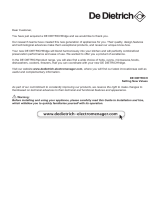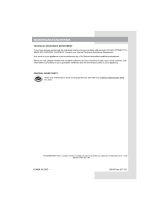
Instructions for Use
14
x Turn the thermostat knob from higher to lower
setting as soon as possible (depending on how
loaded the appliance is, ambient temperature
etc.).
x Never use continuous operation unless it is
absolutely necessary; switch the operation mode
selector switch to the setting for automatic
operation as soon as possible.
x Before freezing packages of fresh foods, make
sure they are cooled to ambient temperature.
x Ice and frost layer increase energy consumption,
so do clean the appliance as soon as the layer is
3-5 mm thick.
x If the gasket is damaged or if it turns out that the
sealing is poor, the energy consumption is
substantially higher. To restore efficiency,
replace the gasket.
x Condenser at the bottom of the appliance must
always be clean and dust free (see section
Cleaning of the appliance).
x Always observe the instructions given in sections
Positioning and Energy saving tips; otherwise the
energy consumption may be substantially higher.
Important
x This appliance is manufactured in compliance
with relevant safety standards. However, it is still
advisable it is not used without due supervision
by persons with diminished physical, motoric, or
mental capabilities or persons with inadequate
experience or knowledge. The same
recommendation applies to minors using the
appliance.
x If you bought this appliance to replace an old one
that was equipped with a lock that cannot be
opened from the inside of the appliance (lock,
bolt), make sure that the lock is broken. This will
make it impossible for the children to lock
themselves into the appliance and suffocate.
x Make sure you connect the appliance correctly to
the power mains (see Connection to the power
mains).
x Do not touch the cooled surfaces while the
appliance operates, especially not with wet
hands, because your skin might stick to the cold
surfaces.
x Do not freeze bottled drinks, especially not fizzy
ones such as mineral water, sparkling wine,
beer, cola etc., because liquid expands during
freezing and the glass bottle is very likely to blow
up.
x Never try to eat frozen food (bread, fruit,
vegetables), because you may get frostbite.
x Carefully check the foods for colour and smell
and if you are in doubt about their quality, throw
them away because they may be spoiled and
therefore dangerous to eat.
x Disconnect the appliance from the power mains
before any repairs (only a qualified technician
should repair it) and before cleaning.
x Use only tools supplied with the appliance or
tools recommended by the manufacturer.
x To protect your environment, be careful not to
damage the rear wall of the appliance (the
condenser unit or the tubes – for example when
moving the appliance) or any part of the
refrigeration system inside the appliance.
x The refrigeration system of the appliance is filled
with refrigerant and lubricant. When the
appliance is damaged, handle it with care and
dispose it of in compliance with environment-
protection precautions (see We care for the
environment).
x Heating element integrated in the appliance, all
around the rim, is controlled by the operation of
the compressor and it prevents the door gasket
to freeze onto the freezer housing.
x If the power supply cord is damaged, it must be
replaced by the manufacturer or his service
agent or a qualified person in order to avoid
hazard.
x The rating plate is located in the interior or on the
rear wall of the appliance.
x Warning! Ventilation slots on the appliance or a
built-in element must always be clean and
unobstructed.
x Warning! Do not use mechanical devices or
tools to defrost the refrigerator, nor any other













